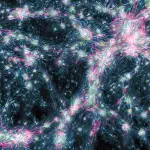Key Takeaways:
- Black holes, enigmatic entities, captivate physicists with their potential for diverse phenomena.
- Studying theoretical charged black holes unveils insights applicable to real-world rotating black holes.
- Superconductor black holes display peculiar features, including a turbulent interior and miniature universes.
- The singularity at the heart of a black hole remains an enigma, defying current understanding.
- Venturing into a superconductor black hole promises a journey into the depths of cosmic complexity.
Black holes stand as some of the most enigmatic and least understood entities in the vast expanse of our universe. They have captivated the attention of physicists for decades due to their immense potential, being associated with phenomena ranging from wormholes to the birth of new universes.
While the known black holes are already peculiar, there exist even more exotic variations that could be conceived. In a speculative version of the universe, a peculiar type of black hole might exist, surpassing the surreal complexity of an M.C. Escher sketch. Recently, a group of researchers has delved into the intricate mathematical core of charged black holes, revealing a plethora of surprises, including a tumultuous expanse of space-time and an exotic fractal landscape, among other potential discoveries.
Introduction to a holographic superconductor
The realm of hypothetical black holes encompasses various possibilities: electrically charged or neutral, rotating or stationary, surrounded by matter or isolated in the void of space. While certain types of black holes are confirmed to exist within our universe, such as the rotating black holes enveloped by infalling matter, others remain purely theoretical. Nevertheless, physicists maintain a keen interest in exploring these theoretical constructs as they provide valuable insights into the foundations of our physical theories, offering potential real-world implications.
One such theoretical archetype is an electrically charged black hole encircled by a peculiar space known as anti-de Sitter space. Without delving deeply into the technical details, anti-de Sitter space possesses a constant negative geometric curvature, akin to that of a saddle, which does not align with the known characteristics of our universe. However, despite its nonexistence within our reality, these exotic black holes exhibit remarkably intricate structures worthy of exploration.
One compelling reason for investigating charged black holes is their close resemblance to rotating black holes, which do exist in our universe. Moreover, charged black holes present a more manageable mathematical framework for study. By scrutinizing charged black holes, researchers can glean insights applicable to real-world rotating black holes.
Additionally, physicists have observed that as these black holes cool down, they develop a “haze” of quantum fields surrounding their surfaces. This haze adheres to the surface, pulled inward by the relentless gravitational force of the black hole while being pushed outward by its electric repulsion. This phenomenon, known as a superconductor, holds practical significance as superconductors can conduct electric current without resistance. Thus, investigating the behavior of superconductors in these exotic scenarios aids in comprehending their mathematical structures, potentially leading to novel applications.
In a recent study published in the preprint database arXiv, a team of researchers utilized the language of superconductivity to uncover deeper insights into these hypothetical black holes.
Exploring the quasi-wormhole
Conventional charged black holes, residing within a typical spacetime framework akin to our universe, exhibit peculiar characteristics within their interiors. Beyond the event horizon lies an inner horizon, a region characterized by intense quantum energies. Further inward lies a wormhole, theoretically connecting to a white hole situated elsewhere in the cosmos.
It is crucial to note the speculative nature of these wormholes, as the mathematical description of charged black holes becomes unreliable at the inner horizon. Consequently, further exploration necessitates advancements in our understanding of physics. Fortunately, the charged black holes surrounded by anti-de Sitter space, henceforth referred to as superconductor black holes, evade this limitation.
While the inner horizon of a superconductor black hole disintegrates, enabling smooth passage without the gravitational distortion experienced in ordinary black holes, the wormhole bridge within also collapses, precluding interstellar travel. However, intriguing phenomena occur just beyond the former inner horizon.
Within the interior of a superconductor black hole, space experiences significant agitation. Analogous to the Josephson Oscillations observed in real-life superconductors, particles oscillate within the black hole, causing space itself to vibrate. Should one venture into these regions, they would encounter a turbulent journey.
A peculiar cosmos
Upon traversing the vibrating space-time, one encounters a truly baffling phenomenon. The innermost regions of a superconductor black hole harbor a miniature expanding universe, where space undergoes deformation at varying rates across different dimensions.
Moreover, depending on the black hole’s temperature, certain regions of space may initiate successive rounds of vibrations, resulting in the creation of expanding space patches at progressively smaller scales. This fractal-like universe defies conventional description, presenting a bewildering landscape of infinite recursion from macroscopic to microscopic scales.
At the heart of this chaotic fractal lies the singularity: a point of infinite density where all matter that has fallen into the black hole converges. Regrettably, even with advanced mathematical techniques, physicists are unable to elucidate the behavior of the singularity, highlighting the necessity for novel theories of gravity.
The journey into a superconductor black hole promises an adventure fraught with enigma, offering a glimpse into the depths of cosmic complexity.


